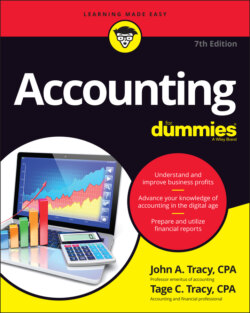Читать книгу Accounting For Dummies - John A. Tracy - Страница 34
Introducing Financial Statements
ОглавлениеIN THIS CHAPTER
Identifying the information components in financial statements
Evaluating profit performance and financial condition
Knowing the limits of financial statements
Recognizing the sources of accounting standards
Chapter 1 presents a brief introduction to the three primary business financial statements: the income statement, the balance sheet, and the statement of cash flows. In this chapter, you get more tidbits about these three financials, as they’re sometimes called. Then, in Part 2, you really get the goods. Remember when you were learning to ride a bicycle? Chapter 1 is like getting on the bike and learning to keep your balance. In this chapter, you put on your training wheels and start riding. Then, when you’re ready, the chapters in Part 2 explain all 21 gears of the financial statements bicycle, and then some.
For each financial statement, we introduce its basic information components. The purpose of financial statements is to communicate information that is useful to the readers of the financial statements, to those who are entitled to the information. Financial statement readers include the managers of the business and its lenders and investors. These constitute the primary audience for financial statements. (Beyond this primary audience, others are also interested in a business’s financial statements, such as its labor union or someone considering buying the business.) Think of yourself as a shareholder in a business. What sort of information would you want to know about the business? The answer to this question should be the touchstone for the accountant in preparing the financial statements.
The financial statements explained in this chapter are for businesses. Business financial statements serve as a useful template for not-for-profit (NFP) entities and other organizations (social clubs, homeowners’ associations, retirement communities, and so on). In short, business financial statements are a good reference point for the financial statements of non-business entities. There are differences but not as many as you may think. As we go along in this and the following chapters, we point out the differences between business and non-business financial statements.
Toward the end of this chapter, we briefly discuss accounting standards and financial reporting standards. Notice here that we distinguish accounting from financial reporting:
Accounting standards deal primarily with how to record transactions for measuring profit and for putting values on assets, liabilities, and owners’ equity.
Financial reporting standards focus on additional aspects such as the structure and presentation of financial statements, disclosure in the financial statements and elsewhere in the report, and other matters.
We use the term financial accounting to include both types of standards.
The philosophy behind the need for standards is that all businesses should follow uniform methods for measuring and reporting profit performance and reporting financial condition. Consistency in financial accounting across all businesses is the name of the game. We won’t bore you with a lengthy historical discourse on the development of accounting and financial reporting standards in the United States. The general consensus (backed by law) is that businesses should use consistent accounting methods and terminology. General Motors and Microsoft should use the same accounting methods; so should Wells Fargo and Apple. Of course, businesses in different industries have different types of transactions, but the same types of transactions should be accounted for in the same way. That is the goal.
